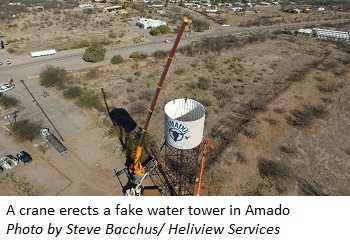Several proposals to erect towers to enhance WiFi networks are coming to Green Valley and Sahuarita, Arizona. One local wireless area network observer estimates there are 24 cell towers now in Green Valley, plus another five antenna arrays in nearby Sahuarita. But there could be as many as 100 soon, according to various experts.
Some poles are located on rooftops, one is on a light pole at a church and others are on utility poles, reports the Green Valley News. Tom Drzazagowski, chief zoning inspector for Pima County Development Services, tells the news outlet a 150-foot lattice-style tower is located near the Titan Missile Museum and can accommodate several service carriers.
Wireless area network buff Dave Doscher advises the Green Valley Council on wireless issues as a volunteer. He believes some 100 new towers and their associated antennae will come into the area over the next few years.
Nearby Verizon representative Rob Jones says there will be more towers coming to the area, but not nearly that many, because some companies will locate their equipment on existing towers or other structures.
Population growth will also impact local wireless service deployment. “Arizona is still growing and adding homes and service,” says Drzazagowski. “Five hundred new homes [or more] will strain the infrastructure and new towers may be needed.”
A Green Valley News report focusing on a main artery, Esperanza Boulevard, showed 64 antenna arrays in the area. The exact number is fuzzy since the county doesn’t keep exact records and many antenna co-locations on existing towers don’t require permits.
The county has permitted five new towers in the last five to seven years. Service gaps are one of the main criteria the county focuses on regarding permit approvals.
If a proposed site is in the middle of a housing development, the county looks for business interests and anything that might screen the structure, according to Drzazagowski. Applicants also speak to neighbors to avoid reactionary responses.
At public hearings, they can ask the applicant to go beyond the required notification of property owners within 300 to 1,000 feet of the site. They can also ask if tower height can be lowered or if the structure can be camouflaged.
Several towers throughout Pima County are disguised as pines, palms, saguaros or church steeples. A reflective film can also be used, as Inside Towers recently reported.
Revenue from tower site leases can be a lure; contracts for anywhere between $9 to $150,000 a month are possible, hammered out in negotiations between the pole owner and property owner, according to the account.
Two current proposals from Verizon are for “macro hubs,” designed to provide more data, higher speed and larger call volume. The area will also see applications for small cells on rooftops and utility poles to fill-in coverage gaps not served by the farther-reaching macros, said experts.





Reader Interactions